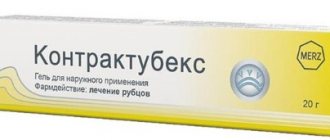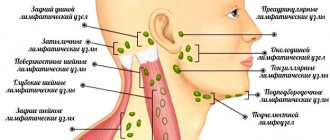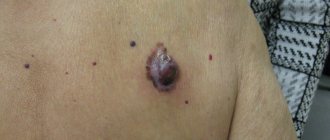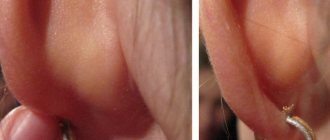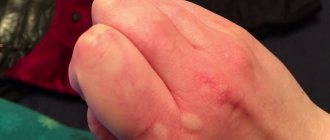In which areas of the human body do boils appear? Except for the soles and palms - everywhere. This is a kind of reminder of our family ties with animals - there is no hair and fur, but the hair follicles remain. Men are less fortunate; they also have stubble in the form of a beard. This is why neck boils appear more often in men.
The close proximity to the head, the commonality of blood flow, and the peculiarities of lymphatic drainage elevate this localization of the boil to the rank of very dangerous diseases.
Taking a look at the photo of a boil on the neck, let’s take a closer look at the causes and treatment.
According to the International Classification of Diseases, 10th revision (ICD10), the code for a boil on the neck is L 02.1. This is under the heading of diseases of the skin and subcutaneous tissue.
What is a boil on the neck?
A furuncle on the neck is an acute, painful inflammatory process in the hair follicle, which is connected to it by the sebaceous gland and adjacent tissue, which resembles red bumps in appearance.
The provoking factor of the disease is a strain of staphylococcus that penetrates the hair follicle when rubbed with clothing, injury or minor damage to the skin.
The boil is predominantly concentrated on the back of the neck, which is associated with regular friction against the collar of clothing. Inflammation is manifested by redness of the skin and swelling; touching the affected area causes discomfort.
On this topic
- Boil
How to recognize and treat a boil under the armpit
- Irina Nasredinovna Nachoeva
- August 19, 2020
The formation of a boil near the neck is very rapid. After 2-3 days, in the midst of suppuration, a green necrotic core appears visible through the skin. After another 2-3 days, the boil bursts and its internal contents are knocked out.
Pus is released for about 2 days and ends with the release of the rod itself. It is not recommended to puncture the abscess and squeeze out its contents or the core on your own, as the likelihood of tissue damage and deep infection increases.
Before the contents come out, patients often experience general weakness: increased body temperature, lethargy, etc.
The ulcerative funnel formed as a result of the exit of the rod begins to scar, and this ends the healing process of the boil. The period from the onset of inflammation to scarring lasts approximately 20 days. But with carbuncles (accumulations of multiple boils), recovery can be delayed.
Stages of ripening and localization features
The infiltration stage is characterized by redness of the skin. The sore spot begins to swell and a slight elevation appears. Tingling and burning are observed, swelling increases. There is a small bubble at the top of the boil. This stage lasts 3 days.
At the next stage (necrosis), the boil matures and begins to break out. As a rule, this is not accompanied by any symptoms other than pain. If the boil is located near the lymph nodes, lymphadenitis is observed. As a rule, on the fourth day the pus comes out. It usually has a yellow-green tint and often contains blood.
The next stage is healing. At this stage, an ulcer forms, which is filled with a certain tissue. The wound heals and the swelling decreases. This stage lasts about three days. A scar remains in place of the chiryak, sometimes it can be pronounced. In general, the disease process lasts 10 days. Provided there are no complications, the boil begins to go away. Often a boil can become abscessed due to a large amount of pus.
A clinical picture of intoxication of the body may also be observed. In such a case, the patient will feel chills and body aches. The temperature may rise to 38 degrees. Appetite often worsens. In such cases, it is recommended to immediately contact a surgeon. The operation to remove the core of the boil allows you to prevent the development of chronic furunculosis against the background of erroneous actions when treating the disease at home.
Causes
The appearance of a boil near the neck is provoked by many circumstances. Harmful staphylococcus, entering the hair follicle, can cause inflammation inside it and in the adjacent sebaceous gland. Infection occurs for a number of reasons, which can be external or internal.
External factors include the following:
- dirty skin and irregular care for it;
- intense sweating, greasy skin;
- traumatism ;
- overheating or hypothermia.
On this topic
- Boil
Let's find out how to treat a boil on the eye
- Irina Nasredinovna Nachoeva
- August 19, 2020
A boil on the neck can be caused by internal factors:
- disorders ;
- diabetes ;
- excess weight ;
- prolonged stressful situations and psycho-emotional stress;
- weakened immune system.
An unbalanced diet and disorders in the functioning of the gastrointestinal tract also affect the formation of boils.
If you shave inaccurately, minor injuries may remain on the skin, through which staphylococcus easily penetrates under it.
Due to the above factors, a recurrent course of the disease occurs, the appearance of multiple suppurations (carbuncles).
What it looks like: photos from the back and front
A furuncle differs from a regular pimple in the large area of the affected area, severe redness of the skin around the pus, and is accompanied by painful sensations. The suppuration can grow to a lump the size of a walnut - a purulent core is located inside the formation.
Most often it appears on the back and where clothes come into most contact with the skin - at the back of the neck, mainly in the lower hair growth zone (it is in this place that clothes come into most contact with the skin, which also sweats a lot). Sometimes boils also appear on the front of the neck.
Pay attention to the photo of purulent inflammation at the initial stage:
Also, the occurrence of a boil can be accompanied by a general malaise - it is important to identify dangerous suppuration in time and begin its treatment in time.
Symptoms
The formation of boils on the neck occurs in stages. The following stages of abscess formation are distinguished:
- red spot appears on the neck There is no physical discomfort.
- Several days will pass and the boil will begin to develop. There will be tingling, burning, and twitching. A white top will become noticeable inside the suppuration.
- After several days, the boil will open and the pus will come out. This will leave a slight deep wound that will heal. Usually small suppurations do not leave scars.
It is forbidden to break through a boil on your neck yourself. There is a high risk of adverse consequences in the form of tissue damage. This may lead to subsequent infection.
Stages of development
The ripening period of a boil is no more than 10 days and includes several stages.
At the first stage of the formation of a boil, a red compaction with an admixture of blood and lymph appears in the tissue area, which is called an infiltrate. Over time, it increases in size and becomes more painful. All this is accompanied by swelling of the surrounding tissues with a clearly noticeable burning sensation. In certain places (neck and face) these symptoms cause the greatest discomfort.
The next stage, which occurs on day 4, is the formation of a necrotic rod in the center of the infiltrate, in the form of a detached hair follicle ending in a purulent pustule. This stage is characterized by an increase in body temperature, increased pain and general malaise, which is accompanied by a deterioration in appetite. At this moment, the inflamed pustule opens and rejects the contents.
The healing process occurs quickly. At the site of inflammation, granulation tissue is formed - young areas of skin. The boil heals, leaving a defect in the form of a scar within 3-4 days. At first it takes on a bright red tint, but over time it fades and becomes invisible.
In rare cases, the maturation of the boil may not be accompanied by the appearance of a rod, however, acute throbbing pain is still present.
Diagnostics
If signs of an inflammatory process of the skin are detected, the patient should visit a dermatologist. The specialist will be able to accurately make a diagnosis based on the results of an external examination and dermatoscopy of the damaged area.
To determine the origin of the virus, bacterial culture of the discharged boil is carried out. Recurrent and multiple neoplasms will be an indication for a general diagnosis of the patient with a laboratory test of blood and urine, a blood test for sugar, urine culture, and rhino- and pharyngoscopy, X-ray, fluorography, and ultrasound.
If the need arises, a person can additionally be advised by specialized doctors. The formation of adverse consequences requires blood cultures for sterility, computed tomography, magnetic resonance imaging, and lumbar puncture.
A boil on the neck should be distinguished from hidradenitis, folliculitis, granuloma, anthrax, skin tuberculosis and other skin diseases.
Treatment
Due to the close location of the boil to the brain and severe pain, it is recommended to visit a specialist at the initial symptoms and select the optimal methods of therapy. At the initial stage of boil formation, a specialist prescribes ultraviolet and electromagnetic irradiation.
Such therapy helps get rid of infectious lesions and prevents the formation of suppuration. If pus is already accumulating, the doctor will prescribe a special drawing ointment, which accelerates the maturation of the boil on the neck and the release of the pus itself.
Antibiotics are used in combination with such medications to reduce the likelihood of infection spreading into the body.
Home therapy includes several methods.
Wet warm compress
It is one of the most effective ways to counteract boils. It is necessary to wet the napkin with water, heat it and apply it with a heating pad to the damaged area on the neck. This helps relieve pain and improve blood flow in that area.
With improved blood circulation, the number of infection-fighting white blood cells increases. Sometimes immersing yourself in a seawater bath can be effective.
Turmeric
It is an antibiotic of natural origin that can relieve inflammation and normalize the functioning of the digestive organs. It is taken orally: 1 tsp. spices and water are washed down with 0.5 liters of water.
Take three times a day. This plant leads to dehydration and constipation, so you should drink plenty of fluids and saturate your diet with foods that are rich in fiber.
Pulling ointments
They accelerate the process of formation of the head of the boil, and also contribute to their opening and the release of suppuration. The following are suitable for this: Vishnevsky ointment, Ichthyol ointment or Levomekol.
It is possible to make the product yourself. It is necessary to melt the butter and add beeswax in a ratio of 4 to 1. The mixture is thoroughly heated, but not boiled, and applied to the boil for 2 days without removing the compress.
If the boil has opened
If the boil bursts and its contents come out, and the inflammatory processes in the tissues near the hole do not go away, you must immediately contact a specialist. In such a situation, the need for surgical intervention arises.
The necrotic core is removed and the contents are cleaned. The procedure is performed under local anesthesia. After removing a boil on the neck, the wound is lubricated with Vishnevsky ointment for several days to speed up recovery.
Surgical intervention is necessary only in situations where there is deep tissue damage and the boil cannot open on its own.
On this topic
- Boil
What threatens a boil inside the nose?
- Irina Nasredinovna Nachoeva
- August 19, 2020
When the formation has opened, the wound should be treated with hydrogen peroxide and covered with a sterile gauze bandage. It is forbidden to press or scratch the boil.
When treating boils, in some cases broad-spectrum antibiotics (Ampicillin, Ampiox) are used. This therapeutic technique quickly eliminates the disease and eliminates the inflammatory process.
When there are a lot of boils, complex treatment is used: a complex of vitamins and immunomodulators are added to the use of medications.
Methods for treating boils on the face at home
You can quickly and effectively cure boils at home by following your doctor’s recommendations.
Therefore, at the first symptoms of pathology, you should contact a dermatologist, and if you cannot get to this specialist, a therapist can prescribe treatment.
In cases where surgical intervention is necessary, a surgeon will provide assistance.
Local treatment with antiseptic agents
To prevent the spread of the inflammatory process, at the first sign of it, the affected area is treated with an antiseptic.
Can be used:
- hydrogen peroxide;
- salicylic alcohol;
- Furacilin solution;
- calendula tincture;
- alcohol 70%.
The source of inflammation should be treated carefully, without pressure, several times during the day.
In order for a boil that is just beginning to form to resolve, treatment with antiseptics begins immediately after the first symptoms appear.
You can speed up the maturation and opening of the abscess with the help of salicylic acid - it is applied to the sore spot and fixed with a bandage.
In order for the boil to open faster and the purulent contents to come out, you should anoint it with the following ointments that have a pulling effect: Vishnevsky, Ichthyol, Heparin. A complete list of ointments for boils is presented at the link.
Antiseptics will also be needed after opening the boil. The cavity cleared of pus is treated with sodium chloride, Syntomycin emulsion, Miramistin, Chlorhexidine, and the skin around the wound is lubricated with brilliant green.
Antibiotics
Antibiotics for boils on the face are prescribed more often than for boils located on other parts of the body.
Broad-spectrum drugs help to successfully combat pathology, help prevent complications and the development of chronic furunculosis.
Antibiotics are prescribed orally or by injection; the following medications may be used:
- Amoxiclav;
- Cephalexin;
- Doxycycline;
- Azithromycin;
- Fusidine sodium;
- Lincomycin.
The duration of antibiotic therapy varies - from 5 to 10 days.
It is recommended to make compresses with ointments that contain antibiotic components:
- Erythromycin;
- Tetracycline;
- Baneocin;
- Oflocaine;
- Levomekol;
- Bactroban.
Applying antibacterial ointments promotes rapid healing of boils.
We have a separate article about taking antibiotics for furunculosis.
Traditional treatment
From the arsenal of folk remedies, you can choose many recipes that help treat boils on the face:
- 2 parts of onions baked in the oven are chopped, mixed with 1 part of grated laundry soap and applied to the boil in the form of a compress. Every 6 - 7 hours the mixture is replaced with freshly prepared one.
- A burdock leaf boiled in milk for a few minutes is applied to the sore spot overnight and fixed with a band-aid, and insulated with a bandage on top.
- Fresh washed plantain leaves are applied in several layers to the boil area and secured with a plaster. The compress is kept for no more than an hour and a half, after which it is replaced with a new one.
- To speed up the maturation and opening of the abscess, prepare a mixture of honey and salt (1 tablespoon each) and the yolk of a fresh chicken egg. A small amount of medicine is applied to the boil, covered with film and fixed for up to 6 hours.
- The boil is smeared with aloe or beet juice several times during the day.
Read the detailed article on how to cure boils at home using traditional methods.
Physiotherapy and others
It is possible to remove the inflammatory process, accelerate the maturation of the abscess, and help tissue regeneration using physiotherapy procedures:
- UFO - ultraviolet irradiation;
- UHF – exposure to an electric field;
- laser therapy;
- electrophoresis using zinc and copper salts;
- darsonvalization;
- ozone therapy.
Physiotherapy procedures are painless, they are used at different stages of boil development.
Often the hidden cause of the formation of boils on the face and head is a weakening of the body's defenses.
Immunostimulants, immunoglobulins, and the use of interferon will help restore immunity.
To combat furunculosis, an autohemotherapy procedure is prescribed - the patient is injected with his own venous blood (subcutaneously or intramuscularly).
In order for the tissues affected by the boil to recover faster and the scars to disappear, use ointments with a resolving effect: Contractubex, Bodyagu, Heparin ointment, Dermatix.
Why is it dangerous?
The neck is one of the most dangerous areas for furunculosis to manifest itself. Here are the blood vessels that supply blood to the brain.
When pus penetrates inside them, adverse consequences can occur - purulent meningitis. Directly because of this, mechanical impact on boils is prohibited.
In the process of penetration of suppuration into the bloodstream, the infection can spread throughout the body and metastasis will appear on the internal organs.
The emerging complication tends to develop quickly, and the patient’s well-being deteriorates sharply. Symptoms of general poisoning occur, body temperature increases, chills may alternate with fever. If treatment is not timely, complications that develop can lead to death.
Which doctor should I contact if nothing helps or the boil cannot be treated?
Sometimes self-treatment can be dangerous to a person’s life and health.
If the inflamed boil does not decrease after several days of treatment or causes severe discomfort, the body temperature is elevated, and the lymph nodes are inflamed, you should urgently seek help from a doctor. A qualified surgeon or dermatologist (at least a therapist, if there are no other specialists in the clinic) will tell you how to treat suppuration and determine whether surgical intervention (cleaning the abscess) with antibiotic therapy is required.
Prevention
To prevent the formation of boils on the neck, the following instructions must be observed:
- adhere to hygiene rules ;
- harden the body;
- strengthen the immune system;
- disinfect minor damage to the skin;
- do not wear clothes with narrow collars.
A balanced diet is important in preventing the disease. A nutritious diet rich in vitamins and minerals prevents obesity and helps strengthen the immune system.
If you suspect a boil, you should immediately consult a specialist and begin treatment for the inflammatory process.
A boil on the neck is an extremely common purulent inflammatory disease. Under the influence of staphylococcus that has penetrated into the hair follicle, suppuration is formed, which affects the follicle itself and nearby tissues.
Due to its close location to the brain, a boil on the neck is very dangerous, as it can cause meningitis. Therefore, it is extremely important to consult a doctor in a timely manner and begin treatment.

